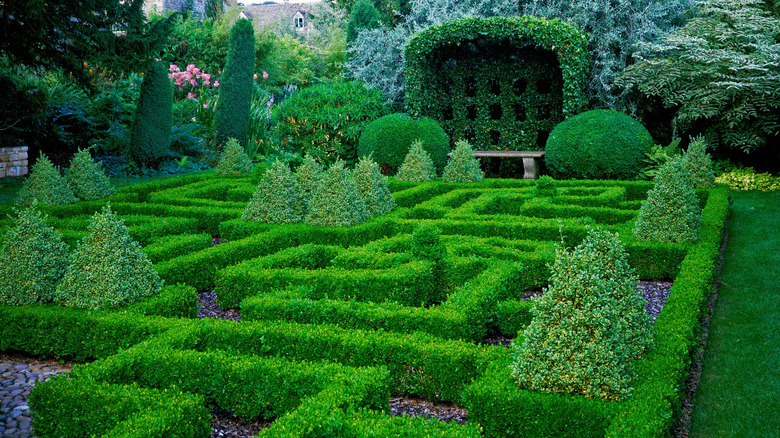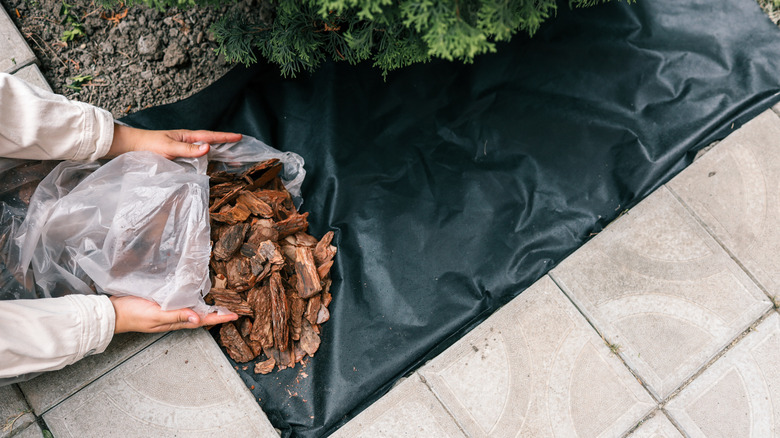How To Keep Knot Gardens Looking Sharp All Summer
The stunning detail of a knot garden draws the eye, but its beauty relies on precision, care, and year-round discipline to maintain the crisp lines and intricate patterns of the plants. These shapely, attention-grabbing gardens can transform even the most basic outdoor areas into spaces that are bursting with charm and dripping with timeless opulence. When spring hits, it's time to pull out those tried-and-true garden tools that are essential for keeping your landscaping looking its best.
Maintenance tasks, such as laying fresh mulch, performing pest control, and deadheading, are must-dos if you want to keep your knot garden on its A-game throughout the summer. In addition, creating a watering plan can help ensure your shrubs stay hydrated throughout the warmer months, which prevents drooping, browning, and stunted growth. Scheduling your seasonal upkeep in batches and by task type can help you stay organized — and doing so may be just the thing to give you that Martha-Stewart, magazine-cover look that so many growers strive for.
Lay fresh mulch and apply pest control sprays
Knot gardens are trendy and inspiring, but they can easily lose their appeal if they become overrun with weeds or pests. Replace mulch every one to two years as it will naturally break down over time and supply fewer nutrients to the soil. Mulch not only helps insulate your soil from hotter temperatures (and colder ones in the fall), but it's also excellent at weed prevention. Be sure to pull any visible weeds before laying your mulch; always water newly laid mulch to help it stay in place.
Critters you may come across include slugs, aphids, grubworms, and various beetles. In some cases, pests can be removed with a quick blast of your water hose, but if you have an infestation, additional measures will be necessary. For slugs, you can set traps on the soil behind shaded areas and monitor them throughout the week. If you notice signs of an infestation on your plant leaves, such as holes or moldy white, black, or brown spots, it's best to add an insecticidal soap or a homemade pest control mix to your watering can.
Water regularly and deadhead flowers as needed
Perhaps some of the most distinguishing features of knot gardens are their lush foliage and sharp, maze-like lines. Both of these features can quickly diminish in warmer climates, but regular watering and deadheading can help maintain the space. Parched leaves may be prone to browning edges or droopiness, negatively impacting the shape and appearance of your garden.
Watering the garden plants throughout the week can help them hold their shape and reduce patchy or thinning areas that leave gaps in the knot garden's patterns. When watering, be mindful of varying irrigation needs for plants based on variety or age — newer plants may require more frequent watering to keep their smaller root systems well-hydrated. Try watering during the cooler parts of the day, such as early morning or late evening, when the sun isn't as strong.
Deadheading your knot garden not only preserves its tidy appearance and sculpted lines but also promotes the growth of new, continuous summer blooms. It encourages your plants to redirect nutrients toward vital stems and leaves, as opposed to dead areas or seed production. Deadheading can help reduce the spread of fungal infections and pest infestations as the decaying blooms often attract pests and diseases. Be sure to avoid common mistakes when deadheading, like neglecting to clean your pruners after each plant and cutting flowerheads straight across — always cut at a 45-degree angle. Pruning shrubs is also important as it maintains the shapes and lines you have established in your knot garden.


